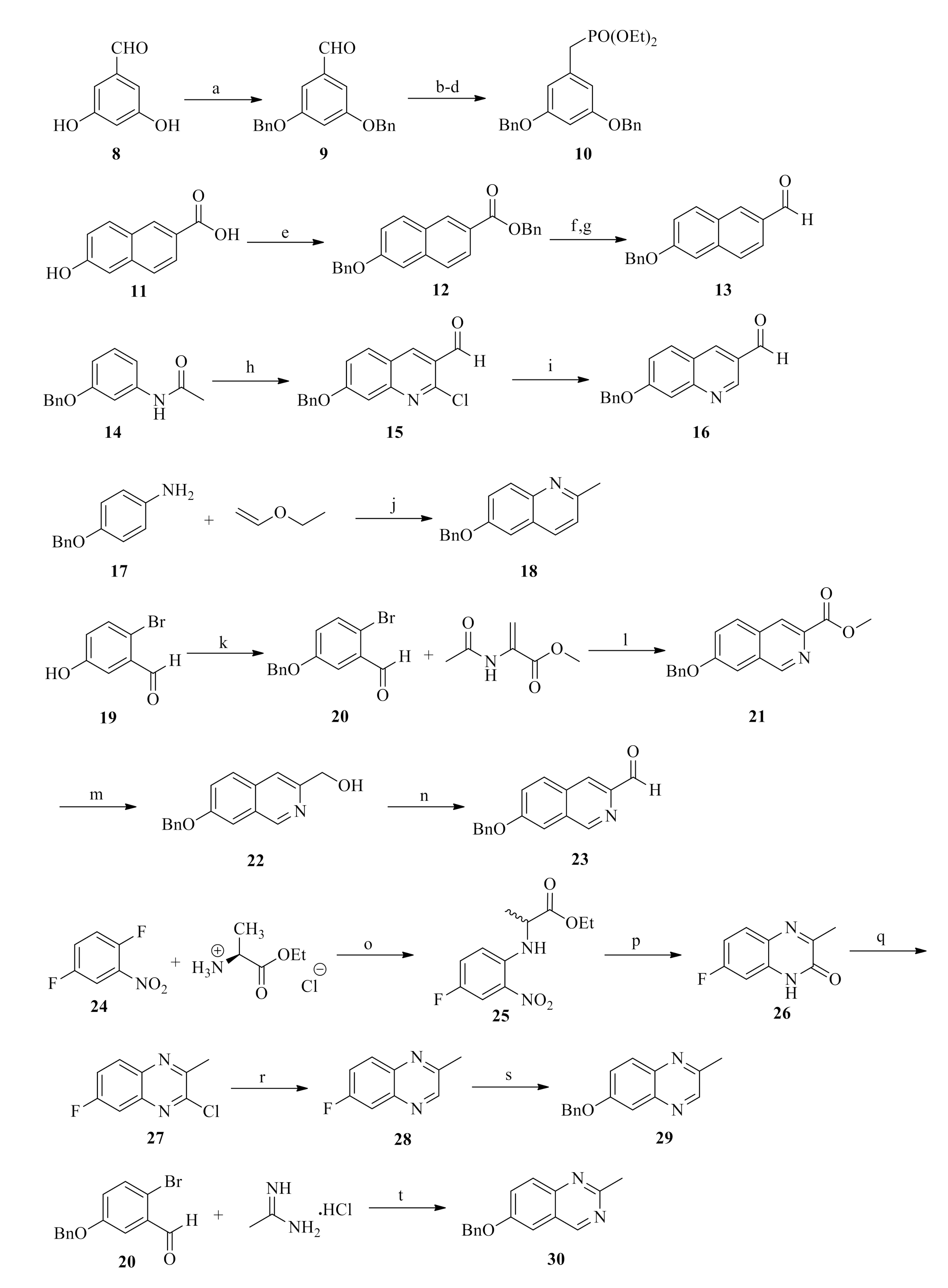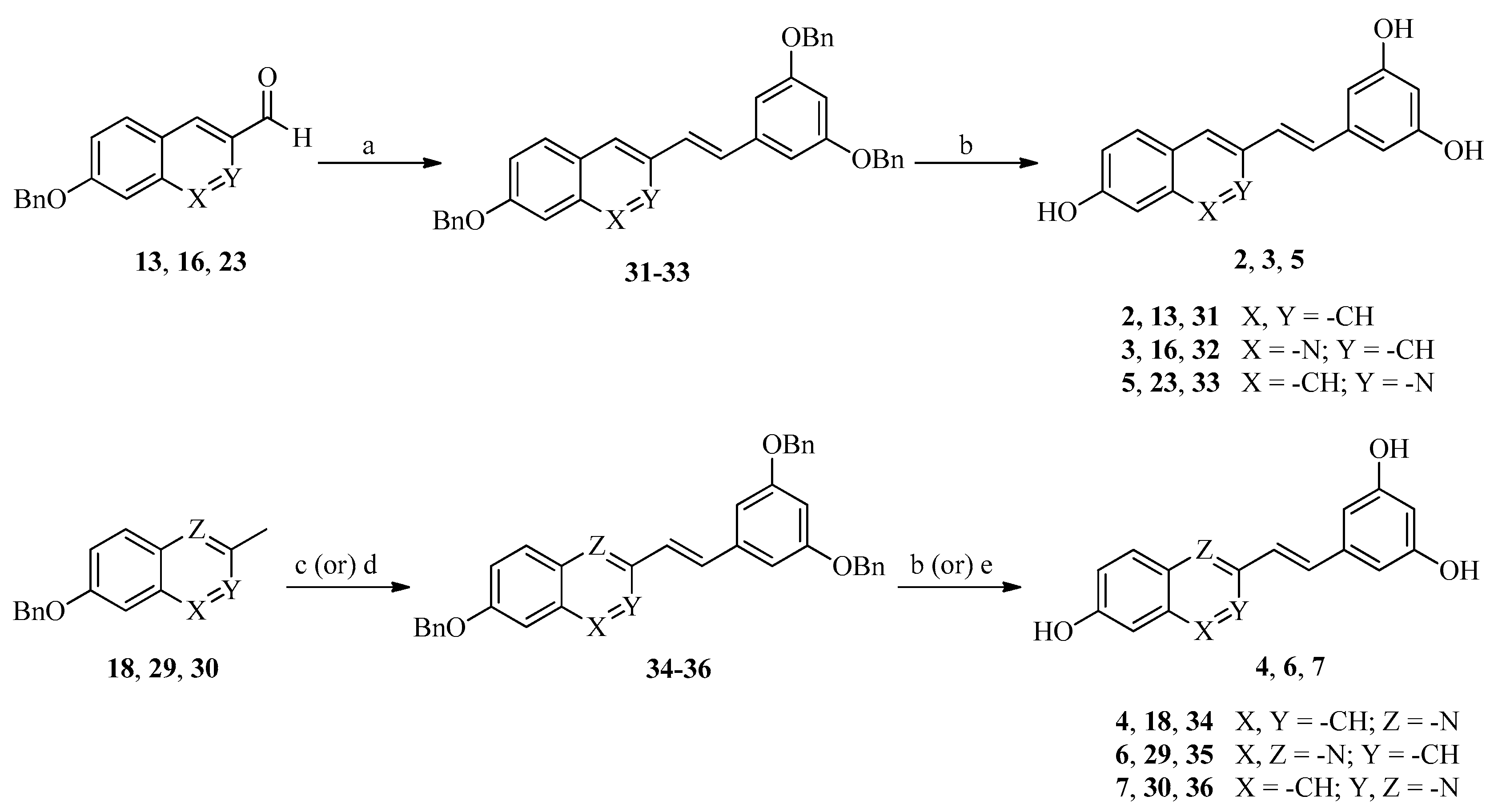Design and Synthesis of π-Extended Resveratrol Analogues and In Vitro Antioxidant and Anti-Inflammatory Activity Evaluation
Abstract
1. Introduction
2. Results and Discussion
2.1. Chemistry
2.2. Antioxidant Activity
2.3. Anti-Iinflammatory Effects on Macrophage
3. Materials and Methods
4. Conclusions
Supplementary Materials
Author Contributions
Funding
Institutional Review Board Statement
Informed Consent Statement
Data Availability Statement
Conflicts of Interest
Sample Availability
References
- Litescu, S.C.; Eremia, S.; Radu, G.L. Methods for the Determination of Antioxidant Capacity in Food and Raw Materials. In Bio-Farms for Nutraceuticals: Advances in Experimental Medicine and Biology; Giardi, M.T., Rea, G., Berra, B., Eds.; Springer: Boston, MA, USA, 2010; Volume 698, pp. 241–249. [Google Scholar]
- Ruttkay-Nedecky, B.; Nejdl, L.; Gumulec, J.; Zitka, O.; Masarik, M.; Eckschlager, T.; Stiborova, M.; Adam, V.; Kizek, R. The Role of Metallothionein in Oxidative Stress. Int. J. Mol. Sci. 2013, 14, 6044–6066. [Google Scholar] [CrossRef] [PubMed]
- Nimse, S.B.; Pal, D. Free radicals, natural antioxidants, and their reaction mechanisms. RSC Adv. 2015, 5, 27986–28006. [Google Scholar] [CrossRef]
- Saeed, N.; Khan, M.R.; Shabbir, M. Antioxidant activity, total phenolic and total flavonoid contents of whole plant extracts Torilis leptophylla L. BMC Complement. Altern. Med. 2012, 12, 221. [Google Scholar] [CrossRef] [PubMed]
- Li, S.; Hong, M.; Tan, H.-Y.; Wang, N.; Feng, Y. Insights into the Role and Interdependence of Oxidative Stress and Inflammation in Liver Diseases. Oxid. Med. Cell. Longev. 2016, 2016, 4234061. [Google Scholar]
- Sharma, J.N.; Al-Omran, A.; Parvathy, S.S. Role of nitric oxide in inflammatory diseases. Inflammopharmacology 2007, 15, 252–259. [Google Scholar] [CrossRef]
- Chatterjee, S. Oxidative Stress, Inflammation, and Disease. In Oxidative Stress and Biomaterials, 1st ed.; Dziubla, T., Butterfield, D.A., Eds.; Academic Press: Cambridge, UK; Volume 2016, pp. 35–58.
- Rauf, A.; Imran, M.; Suleria, H.A.R.; Ahmad, B.; Peters, D.G.; Mubarak, M.S. A comprehensive review of the health perspectives of resveratrol. Food Funct. 2017, 8, 4284–4305. [Google Scholar] [CrossRef]
- Salehi, B.; Mishar, A.P.; Nigam, M.; Sener, B.; Kilic, M.; Sharifi-Rad, M.; Fokou, P.V.T.; Martins, N. Sharifi-Rad, Resveratrol: A Double-Edged Sword in Health Benefits. Biomedicines 2018, 6, 91. [Google Scholar] [CrossRef]
- Singh, A.P.; Singh, R.; Verma, S.S.; Rai, V.; Kaschula, C.H.; Maiti, P.; Gupta, S.C. Health benefits of resveratrol: Evidence from clinical studies. Med. Res. Rev. 2019, 39, 1851–1891. [Google Scholar] [CrossRef]
- Wenzel, E.; Somoza, V. Metabolism and bioavailability of trans-resveratrol. Mol. Nutr. Food Res. 2005, 49, 472–481. [Google Scholar] [CrossRef]
- Cao, H.; Pan, X.; Li, C.; Zhou, C.; Deng, F.; Li, T. Density functional theory calculations for resveratrol. Bioorg. Med. Chem. Lett. 2003, 13, 1869–1871. [Google Scholar] [CrossRef]
- Iuga, C.; Alvares-Idaboy, J.R.; Russo, N. Antioxidant Activity of trans-Resveratrol toward Hydroxyl and Hydroperoxyl Radicals: A Quantum Chemical and Computational Kinetics Study. J. Org. Chem. 2012, 77, 3868–3877. [Google Scholar] [CrossRef] [PubMed]
- Shang, Y.-J.; Qian, Y.-P.; Liu, X.-D.; Dai, F.; Shang, X.-L.; Jia, W.-Q.; Liu, Q.; Fang, J.-G.; Zhou, B. Radical-Scavenging Activity and Mechanism of Resveratrol-Oriented Analogues: Influence of the Solvent, Radical, and Substitution. J. Org. Chem. 2009, 74, 5025–5031. [Google Scholar] [CrossRef] [PubMed]
- Li, X.; Xie, Y.; Xie, H.; Yang, J.; Chen, D. π-π Conjugation Enhances Oligostilbene’s Antioxidant Capacity: Evidence from α-Viniferin and Caraphenol, A. Molecules 2018, 23, 694. [Google Scholar] [CrossRef]
- Tang, J.-J.; Fan, G.-J.; Dai, F.; Ding, D.-J.; Wang, Q.; Lu, D.-L.; Li, R.-R.; Li, X.-Z.; Hu, L.-M.; Jin, X.-L.; et al. Finding more active antioxidants and cancer chemoprevention agents by elongating the conjugated links of resveratrol. Free Radic. Biol. Med. 2011, 50, 1447–1457. [Google Scholar] [CrossRef]
- Hicks, R.G. What’s new in stable radical chemistry? Org. Biomol. Chem. 2007, 5, 1321–1338. [Google Scholar] [CrossRef]
- Ritchie, T.J.; Macdonald, S.J.F. Heterocyclic replacements for benzene: Maximising ADME benefits by considering individual ring isomers. Eur. J. Med. Chem. 2016, 124, 1057–1068. [Google Scholar] [CrossRef]
- Fukuhara, K.; Nakanishi, I.; Matsuoka, A.; Matsumura, T.; Honda, S.; Hayashi, M.; Ozawa, T.; Miyata, N.; Saito, S.; Ikota, N.; et al. Effect of methyl substitution on the antioxidative property and genotoxicity of resveratrol. Chem. Res. Toxicol. 2008, 21, 282–287. [Google Scholar] [CrossRef]
- Meth-Cohn, O.; Narine, B.; Tarnowski, B. A versatile new synthesis of quinolines and related fused pyridines, Part 5. The synthesis of 2-chloroquinoline-3-carbaldehydes. J. Chem. Soc. Perkin Trans. 1520, 1, 1520–1530. [Google Scholar] [CrossRef]
- Le, S.T.; Yasuok, C.; Asahara, H.; Nishiwaki, N. Dual Behavior of Iodine Species in Condensation of Anilines and Vinyl Ethers Affording 2-Methylquinolines. Molecules 2016, 21, 827. [Google Scholar] [CrossRef]
- Morimoto, H.; Sakamoto, T.; Himiyama, T.; Kawanishi, E.; Matsumura, T. Aromatic Nitrogen-Containing 6-Membered Ring Compounds and Their Use. WO Patent 2010030027, 2010. Available online: https://patentscope.wipo.int/search/en/search.jsf (accessed on 23 January 2021).
- Hunga, C.; Fu, Y.; Fu, H.; Jiang, Y.; Zhao, Y. Highly efficient copper-catalyzed cascade synthesis of quinazoline and quinazolinone derivatives. Chem. Commun. 2008, 6333–6335. [Google Scholar] [CrossRef] [PubMed]
- Pi, D.; Jiang, K.; Zhou, H.; Sui, Y.; Uozumi, Y.; Zou, K. Iron-catalyzed C(sp3)–H functionalization of methyl azaarenes: A green approach to azaarene-substituted α- or β-hydroxy carboxylic derivatives and 2-alkenylazaarenes. RSC Adv. 2014, 4, 57875–57884. [Google Scholar] [CrossRef]
- Akiyama, T.; Hirofuji, H.; Ozaki, S. AlCl3-N, N-dimethylaniline: A new benzyl and allyl ether cleavage reagent. Tetrahedron Lett. 1991, 32, 1321–1324. [Google Scholar] [CrossRef]
- Amorati, R.; Valgimigli, L. Advantages and limitations of common testing methods for antioxidants. Free Radic. Res. 2015, 49, 633–649. [Google Scholar] [CrossRef] [PubMed]
- Morbidelli, L.; Bonavida, B. Therapeutic Application of Nitric Oxide in Cancer and Inflammatory Disorders, 1st ed.; Academic Press: Cambridge, UK, 2019. [Google Scholar]
- Giusarini, D.; Rossi, R.; Milzani, A.; Dalle-Donne, I. Nitrite and nitrate measurement by Griess reagent in human plasma: Evaluation of interferences and standardization. Methods Enzymol. 2008, 440, 361–380. [Google Scholar]
- Mazzio, E.A.; Bauer, D.; Mendonca, P.; Taka, E.; Soliman, K.F. Natural product HTP screening for attenuation of cytokine-induced neutrophil chemo attractants (CINCs) and NO2 − in LPS/IFNγ activated glioma cells. J. Neuroimmunol. 2017, 302, 10–19. [Google Scholar] [CrossRef]
- Kim, J.H.; Shyam, P.K.; Kim, M.J.; Lee, H.-J.; Lee, J.T.; Jang, H.-Y. Enantioselective synthesis and antioxidant activity of 3,4,5-substituted piperidine derivatives. Bioorg. Med. Chem. Lett. 2016, 26, 3119–3121. [Google Scholar] [CrossRef]
- Barltrop, J.A.; Owen, T.C.; Cory, A.H.; Cory, J.G. 5-(3-carboxymethoxyphenyl)-2-(4,5-dimethylthiazolyl)-3-(4-sulfophenyl)tetrazolium, inner salt (MTS) and related analogs of 3-(4,5-dimethylthiazolyl)-2,5-diphenyltetrazolium bromide (MTT) reducing to purple water-soluble formazans As cell-viability indicators. Bioorg. Med. Chem. Lett. 1991, 1, 611–614. [Google Scholar]




| Compound | IC50 (μM) | Compound | IC50 (μM) |
|---|---|---|---|
| Ascorbic acid | 19.82 ± 0.934 | 4 | 3.61 ± 0.253 |
| 1 | 4.88 ± 0.350 | 5 | 2.81 ± 0.034 |
| 2 | 3.14 ± 0.445 | 6 | 3.10 ± 0.953 |
| 3 | 3.57 ± 0.496 | 7 | 3.54 ± 0.714 |
| Compound | NO/MTT Assay ED50 (μM) | Cell Viability LD50 (μM) | iEI (LD50/ED50) |
|---|---|---|---|
| 1 | 26.89 ± 1.210 | 81.08 ± 9.258 | 3.02 |
| 2 | 29.50 ± 0.168 | 28.82 ± 0.767 | 0.98 |
| 3 | 44.60 ± 7.273 | 167.12 ± 13.652 | 3.75 |
| 4 | 38.81 ± 1.878 | 123.47 ± 6.388 | 3.18 |
| 5 | 13.08 ± 0.690 | 63.30 ± 1.139 | 4.84 |
| 6 | 56.88 ± 1.613 | 120.46 ± 4.237 | 2.11 |
| 7 | 21.67 ± 1.101 | 92.58 ± 8.745 | 4.27 |
Publisher’s Note: MDPI stays neutral with regard to jurisdictional claims in published maps and institutional affiliations. |
© 2021 by the authors. Licensee MDPI, Basel, Switzerland. This article is an open access article distributed under the terms and conditions of the Creative Commons Attribution (CC BY) license (http://creativecommons.org/licenses/by/4.0/).
Share and Cite
Nam, K.Y.; Damodar, K.; Lee, Y.; Park, L.S.; Gim, J.G.; Park, J.P.; Jeon, S.H.; Lee, J.T. Design and Synthesis of π-Extended Resveratrol Analogues and In Vitro Antioxidant and Anti-Inflammatory Activity Evaluation. Molecules 2021, 26, 646. https://doi.org/10.3390/molecules26030646
Nam KY, Damodar K, Lee Y, Park LS, Gim JG, Park JP, Jeon SH, Lee JT. Design and Synthesis of π-Extended Resveratrol Analogues and In Vitro Antioxidant and Anti-Inflammatory Activity Evaluation. Molecules. 2021; 26(3):646. https://doi.org/10.3390/molecules26030646
Chicago/Turabian StyleNam, Ki Yoon, Kongara Damodar, Yeontaek Lee, Lee Seul Park, Ji Geun Gim, Jae Phil Park, Seong Ho Jeon, and Jeong Tae Lee. 2021. "Design and Synthesis of π-Extended Resveratrol Analogues and In Vitro Antioxidant and Anti-Inflammatory Activity Evaluation" Molecules 26, no. 3: 646. https://doi.org/10.3390/molecules26030646
APA StyleNam, K. Y., Damodar, K., Lee, Y., Park, L. S., Gim, J. G., Park, J. P., Jeon, S. H., & Lee, J. T. (2021). Design and Synthesis of π-Extended Resveratrol Analogues and In Vitro Antioxidant and Anti-Inflammatory Activity Evaluation. Molecules, 26(3), 646. https://doi.org/10.3390/molecules26030646






